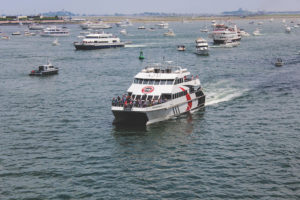
Another week has gone by, and we are still living in a world where social distancing is very much a part of our day-to-day lives. At this point, it’s time for waterfront businesses to start planning how they will operate under tough parameters.
The first thing that becomes evident is that commercial vessels are not going to be able to carry nearly as many passengers as their licenses allow and still be compliant with the six-feet-apart rule.
The Cee Jay, the charter fishing boat I run, has 45 feet of railing on either side. At six feet apart, I can put seven passengers on each side of the boat. The stern, at 10 feet wide, allows for one person in the middle. That’s a total of 15 passengers per trip within social distancing parameters.
Then there’s the whale watch boats. They are licensed for 250 passengers. Using the same formula, with 100 feet of railing per side on the lower deck, only 16 passengers would be allowed on each side. The upper deck, roughly 50 feet long, permits eight passengers on each side. The stern railing would allow for two more. That’s a total of 50 passengers on a 250-passenger boat. Six-passenger charter boats are looking at a one to three passenger limit, depending on the boat.
The ferries from Boston would also have to reduce their passenger-carrying capacity by roughly two thirds. Maintaining social distancing on these boats will significantly affect their income stream. Whether operating at reduced capacity is enough to sustain these businesses depends on the individual business, but given the shortness of our season, it will put them under considerable stress. Still, it beats the heck out of not operating at all.
Marinas are yet another story. As of this writing, both Provincetown Marina and Northside Marina in East Dennis are proceeding with business as usual and taking slip and mooring reservations. I would imagine that, if Gov. Baker keeps social distancing measures in place throughout the summer, common facilities at marinas, such as bathrooms, showers, lounging areas, and on-site restaurants, might have to be off limits, and customers would essentially be required to stay on their boats. The launch boat that picks people up from their mooring to bring them to shore would also have to reduce its passenger-carrying capacity, or mooring customers would have to use their personal skiffs to go back and forth.
The bottom line is, we are looking at a vastly different landscape on the waterfront if the virus still has us in a stranglehold come June and July.
Charles Darwin said the adaptation of a species to a changing environment is the primary determining factor as to whether it survives. That theory is being severely tested at the moment, and time will tell how we fare.
Otherwise, there’s not much to report on the fishing scene, as not many people are out. Striped bass continue to push north towards us, and mackerel are around Cape waters. The weather remains strangely inhospitable to a day of fishing.
Commercial regulations just came out for striped bass. The overall quota has been reduced by 20 percent and the minimum keeper size has been increased from 34 to 35 inches. The bag limit remains 15 per day. The commercial season opens on June 24, with Mondays and Wednesdays the only days for commercial boats to work.
